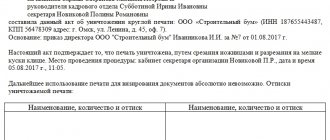In every organization, sooner or later there comes a time when it is necessary to get rid of old documents and make room for new ones. But there is no concept of “old documents” in archiving. There are only documents that have expired. You can get rid of them, but not immediately and not all of them. First, you will have to review the documents and select those that can be safely destroyed.
No matter how great the temptation may be to take all the “old” documents anywhere out of sight, you should never do this - no one has canceled liability for violating the requirements of the law on storing documents. In accordance with Art. 13.25 of the Code of the Russian Federation on Administrative Offenses (hereinafter referred to as the Code of Administrative Offenses of the Russian Federation), the fine for a legal entity can range from 200 to 300 thousand rubles. In practice, liability for an organization may arise if it does not provide any document at the request of a regulatory authority, citing the fact that it is lost or destroyed. This is why thoughtlessly destroying documents is risky.
What documents can be destroyed?
When deciding to destroy documents, you must be guided by the main criterion - the storage period. If it has expired, then the document can be sent to the shredder (or oven) provided that you have correctly determined the expiration date.
Guided by this rule, you can make a list of documents of different “ages” that are subject to destruction in 2020:
| Year of completion in office work | Shelf life |
| 1941 | 75 years old |
| 1971 | 45 years |
| 2006 | 10 years |
| 2011 | 5 years |
| 2013 | 3 years |
| 2015 | 1 year |
It is impossible to immediately select documents for destruction. First, a value assessment must be conducted. In this case, shelf life will be the determining, but not the only selection criterion. An expired document may be useful in future work. It is possible that it may be of scientific, even historical value. This can be established, and therefore the shelf life can be extended, only by a value examination (VE), which is carried out by an expert commission (EC).
Form of acts
Act on the allocation of documentation for destruction
An act on the allocation of documentation for destruction is usually drawn up in the form given in Appendix No. to Order of the Ministry of Culture of Russia No. 526. Also, each organization has the right to draw up this act according to an independently developed template, without using a unified form.
If the act is drawn up in free form, it must include the following information:
- Title of the document;
- name of company;
- date of compilation;
- name and details of the document that became the basis for the procedure;
- a list of documents that will be destroyed and their quantity;
- FULL NAME. and signatures of commission members.
The act of allocating documentation for destruction according to a unified form consists of several sections:
- "A cap". Here you need to indicate the name of the business entity, the act number and the date of its execution, full name. and the signature of the manager who approved the document.
- Preamble - indicate the name of the regulatory document, which is the basis for determining the storage periods for documentation and their destruction.
- Main part. This section should list the names of documents selected for destruction and their quantity. For convenience, documentation is grouped by structural divisions.
- The operative part is the total number of documents allocated for disposal, indicating in which years they were issued. You should also indicate the method of destruction and details of the minutes of the meeting of the expert commission.
- Signature of the archivist or other person responsible for storing documentation.
When drawing up acts of destruction of documents, storage periods are checked against the list approved by Order No. 236 of Rosarkhiv dated December 20, 2019. The list came into force on February 18, 2020.
Expert commission: composition and functions
EC appears in the organization immediately after management decides to create an archive. The secretary of the EC is always an archivist, and the chairman is either a top manager to whom the clerks report (for example, the administrative director), or, as in our example, the director for general affairs. If one is not found - the general director himself, who signs the order to create a commission (Example 1). The same order can approve the regulations on the new collegial body and request a plan for its work. If the date of creation of the EC is not indicated in the order, it is considered that the commission operates from the date of signing the order.
1Not shown.
The EC is a collegial advisory body under the general director of the organization. “Collegial” means that the commission includes several officials from among the organization’s employees, “deliberative” - the officials do not make a decision, but only recommend to the general director to carry out this or that operation on documents and approve it.
A clerk or archivist knows management documents well, but in the organization’s archive there is also a huge layer of personnel records, accounting and tax reporting, and documents accompanying the organization’s core activities. Since these are independent documentation systems, only specialists can evaluate them. For this purpose, an expert commission is created - a meeting of competent (each in their own field) officials.
The main function of the EC in an organization that is not a source of acquisition of the state (municipal) archive is to organize the annual selection of files for storage and destruction.
In organizations that are sources of acquisition of the state archive, the functionality of the EC is broader: the commission actively interacts with the expert verification commission of the archival institution, submits to them for approval draft nomenclatures of files, archival inventories, and makes proposals for changing the storage periods of documents.
Regardless of the company’s field of activity, the EC must include:
• head of the HR department;
• chief accountant;
• head of the legal department;
• an official in the company's profile (production manager, construction manager, chief technologist, etc.), whose task is to evaluate documents on the main activities of the organization.
Each EC meeting is documented in minutes (Example 2).
Rules and time for storing accounting documents
Procedure for storing financial documentation of the accounting department
The rules for storing accounting documentation from the moment of its release to destruction are regulated by the standards of various legal areas. The legislative framework regarding this issue includes the following legal documents:
- Regulations on documents and document flow in accounting, established by Order of the Ministry of Finance of the USSR dated July 29, 1983 No. 105 (hereinafter referred to as the Regulations).
- Rules for the operation of enterprise archives, adopted by a collegial decision of the State Archives of February 6, 2002 (hereinafter referred to as the Rules).
- Federal Law of October 22, 2004 125-FZ “On archiving in the Russian Federation” (hereinafter referred to as the Law);
- A list of standard organizational archival documents created during the work of state and non-state enterprises with clarification of the timing of their archiving, established by order of the Ministry of Culture of the Russian Federation dated August 25, 2010 No. 558 (hereinafter referred to as the List).
You need to obtain primary information about what storage time standards are established by law for a particular accounting document in the List. At the moment, it has been updated and reflects the rules and terms for storing documentation of all types of institutions and enterprises, regardless of their organizational and legal form. For the convenience of users, the documents in the List are grouped by management functions. Thus, the fourth section of the List “Accounting and Reporting” is divided into subgroups 4.1. “Accounting and reporting” and 4.2. “Statistical accounting and reporting”, which helps to navigate and find the rules for storing and destroying the documents of interest.
As established by Federal Law No. 402-FZ of December 6, 2011, which came into force on January 1, 2013, all financial and accounting documentation must be kept by business entities for as long as established by the Rules for the Organization of State Archives. According to Article 29 of the same Law “On Accounting”, the procedure for destroying accounting documents must be applied to documentation that has been stored for at least five years. The same rule is duplicated by paragraph 98 of the Regulations on accounting and financial reporting in the Russian Federation, approved by order of the Ministry of Finance of Russia dated July 29, 1998 No. 34n.
If you study the tax and legal legislative framework of the Russian Federation, you will notice that for tax agents the procedure for storing financial papers with information on accounting or financial statements requires a four-year storage period. Consequently, the destruction of a document confirming a financial transaction before the expiration of the storage period is prohibited (regulated by subparagraph 8 of paragraph 1 of Article 23 of the Tax Code of the Russian Federation).
For operating and non-operating joint stock companies, the procedure for archiving and liquidation of organizational documents is regulated by the Regulations on the procedure and terms for preserving JSC documentation, approved by Resolution of the Federal Commission for the Securities Market dated July 16, 2003 No. 03-33/ps.
For legal entities of the organizational and legal form of LLC, the requirements for storing paper information media before their destruction are presented in Article 50 of the Law of February 8, 1998 No. 14-FZ “On Limited Liability Companies”.
Read material on the topic: Accounting services for companies
Methods for storing accounting documents
To ensure the preservation of the suitability of documents, enterprises often resort to organizing an internal archive. The right to create an archive is a legally established norm for organizations engaged in commercial and non-profit activities, and is explained in Law 125-FZ. During the storage of documentation, enterprises have the right to independently choose the type of storage of accounting documents until they are destroyed (in the internal archive or by an engaged specialized company).
1. Organization of the internal archive of the enterprise
The procedure for destroying accounting documents is preceded by their proper storage. So, if the head of a company decides to create an archive to preserve the usefulness of documentation, then it should be a separate room equipped with special shelves, racks and other means for storing paper and other information media. In addition, climate, humidity and safety control systems must be installed in the room.
The procedure for organizing an internal archive implies the following recommendations:
- The procedure for storing paper documents requires their preservation in full suitability until destruction. Therefore, the archive room should be protected as much as possible from direct sunlight, which can be achieved by simply curtaining the windows;
- The document must be carefully guarded until destroyed. Therefore, if the company’s archives are located on the first or ground floors, the window openings should be equipped with bars, and the entrance should be equipped with a metal door;
- documentation stored in the archive should be systematized into separate groups or lists. This procedure will not only tidy up the contents of financial papers in the storage facility, but will also make it easier for employees to find the necessary materials. The original list is intended for storage by the manager, and the copy is for the internal archive of the enterprise;
- access to accounting papers must be carried out in strict order and under control. For example, employees of other departments cannot receive documents from the accounting department. An exception may be the provision of access upon receipt of written permission from the director or chief accountant.
2. Off-site archiving of economic documents
To ensure the safety of accounting and other documents until they are destroyed, some modern companies resort to the help of specialized assistants - services for off-site archiving of documentation. Such assistance companies offer to place information media in premises specially equipped for these purposes and fully comply with the standards established by law. This service is especially popular among small companies, for which maintaining their own storage is costly both financially and time-consuming. In addition, storing documents with third parties frees up additional space in offices, which subsequently further reduces the costs of a small business.
The applied procedure for off-site archiving is convenient not only for the company itself, but also for its chief accountant: there is no additional burden on creating a repository, a nomenclature list of documents, providing access, searching, etc.
Read the material on the topic: How to restore accounting
Responsibility for deviation from the procedure for storing accounting documents before their destruction
The management of the enterprise should always remember that the procedure for destroying accounting documents is preceded by their proper archiving, for violation of the rules of which liability is imposed. So, if during an audit of the archive or a visit from tax officials, the further unsuitability of an accounting document or its untimely destruction is revealed, the manager and chief accountant of the company faces administrative liability in the form of:
- imposing a fine in the amount of 300 - 500 rubles - assigned to an authorized person for violating the procedure for storing documentation (Article 13.20 of the Code of Administrative Offenses of the Russian Federation);
- imposition of a fine in the amount of 2 - 3 thousand rubles - imposed for a gross violation of the procedure for implementing accounting and reporting control and the rules for archiving accounting documents, including the absence of 1/10 of the total number of documents reflecting accounting data (Article 15.11 of the Code of Administrative Offenses of the Russian Federation);
- imposing a fine in the amount of 10 - 30 thousand rubles - assigned to an organization that has lost tax reporting documents (for example, invoices or accounting registers). This norm is applied in accordance with Article 120 of the Tax Code of the Russian Federation for gross non-compliance with the requirements for accounting for income/expenses of an enterprise.
If the primary accounting documentation of an enterprise is lost, its director is obliged to issue an order to appoint a commission to investigate evidence of the loss (clause 6.8 of the Regulations).
If the disappearance of accounting documents was the result of unforeseen situations or illegal acts of attackers, this must be confirmed by a certificate from the witnessing government services. For example, the destruction of documents by fire is proven by the conclusion of the fire control service, and their theft is proven by a document issued by the police station.
Read material on the topic: Types of tax audits and their features
If the value examination is carried out for the first time
The first assessment of value is always a large-scale event. It is necessary to review all the documents that have accumulated over the years of the organization’s existence. The expert commission must act consistently.
■ Step 1: select the documents for which the value assessment will be carried out.
At this stage of the examination, members of the EC do not participate. This is the area of responsibility of the archivist (clerk, secretary) and employees of the company’s structural divisions. They separate documents that were completed before the beginning of the current year from those that are still in progress.
■ Step 2: divide the documents by year. This stage is relevant during the first EC, when absolutely everything that has been completed in office work has to be reviewed.
The first thing to do to put things in order is to separate the documents by year. Perhaps the employees who were responsible for these documents have done this before. If not, you'll have to do it now. The archivist and department employees are still responsible; it is too early to involve EC members.
■ Step 3: we conduct an examination. At this stage, the main role in the examination is played by the members of the EC, who review the documents prepared for assessment and divided by year and make a verdict: whether they represent practical (scientific, historical) value or not. After this, the part of the documents that has received the status “may be destroyed” is checked by the archivist. He finds out whether the storage periods for these documents have expired.
■ Step 4: we formalize the results of the examination. The results of the examination of value are recorded, firstly, in the inventory of cases and documents, and secondly, in the act of allocating documents for destruction.
■ Step 5: we coordinate and approve inventories and acts. After the documents that record the results of the value assessment have been drawn up, a meeting of the expert commission is held. On it, members of the EC agree on the inventory and act, after which they are approved by the General Director.
■ Step 6: we prepare documents for storage and destruction. Those files and documents that remain in the organization are registered for storage. For those that are decided to be destroyed, a recycling process is organized.
We draw up an act on the allocation of papers for destruction
Let's consider a sample act on the allocation of documents for destruction:
- the document is drawn up on the company’s letterhead;
- in the center of the sheet we indicate the name of the document, the date of its preparation and number;
- in the text of the act we provide the regulatory legal act in accordance with which the documentation was selected;
- It is more convenient to arrange the list in the form of a table in which it is necessary to make such columns as the period of preparation of documents, their quantity and the period of their storage;
- in the “Total” column we indicate the total number of securities;
- at the end we write down the composition of the commission members with the names of their positions and full names;
- in the upper right corner of the sheet, in the “I approve” column, the name of the manager’s position, his full name, and date are indicated.
.
Document destruction process
Document destruction is usually carried out in one of two ways: by burning or shredding. The latter is only provided that the documents cannot be restored. Documents should not be sent to the nearest landfill, torn into pieces, or used as drafts.
As a rule, special organizations are hired to destroy documents . Most often, these organizations offer shredding as a method of destruction, and the resulting waste can be immediately accepted as waste paper, thereby returning part of the cost of their services. At the request of the customer, the contractor can film the destruction process. Representatives of the customer organization may also be present when documents are destroyed.
A standard contract for the provision of services for a fee is drawn up with the organization that deals with the destruction of documents. The contractor will propose a standard form of the contract at the negotiation stage. All that is required of the archivist is to ensure that the contract contains a clause stating that the executor undertakes to ensure the confidentiality of the documents being destroyed, since among them there may be cases that contain personal data, commercial or other types of secrets. To avoid wasting time sorting classified and unclassified documents that will soon be nothing more than shavings, contractors ensure confidentiality by default.
You can destroy documents on your own if production capacity allows, for example, a furnace or industrial shredder is operating in the workshops of the enterprise. An attempt to get rid of documents using an ordinary office shredder is doomed to failure if the volume of papers exceeds one folder.
Who deals with document disposal?
To destroy documents, a special commission is created, which must include at least two people. Usually these are employees of different structural divisions of the enterprise, including the department whose documents are subject to disposal. The signatures of each of them must be on the act of destruction of papers.
At the same time, we should not forget that the members of the commission are responsible for the documents destroyed. That is why this process should be treated very carefully in order to prevent the disposal of papers that have not lost their significance.
We must not forget that most documents should be stored for at least five years, otherwise serious sanctions from supervisory authorities are possible.
Document destruction act
The destruction of files from the moment of selection to sending to the shredder is documented in one document - an act on the allocation for destruction of archival documents that are not subject to storage. The form is approved by the Rules for organizing the storage, acquisition, recording and use of documents of the Archival Fund of the Russian Federation and other archival documents in government bodies, local governments and organizations in Appendix No. 21 (Example 3).
As can be seen from the example, the document destruction act conditionally consists of two parts. The first is a list of cases and documents allocated for destruction, the second informs about how exactly the documents were destroyed.
Let's go through the act and consider the basic rules for filling out its unified form.
The first part of the act: registration rules
1. The name of the organization can be either full or short. The main thing is that the name stated in the act corresponds to the organization’s charter.
2. Acts on the destruction of documents must be registered, like other documents. The act is assigned a serial number according to the corresponding registration form. The date of the act must correspond to the date of its approval.
3. The act is approved by the general director.
4. Documents are selected for destruction on the basis of regulations establishing storage periods. And this is not only the 2010 List. We have included as an example an industry document containing retention periods to show what several such documents look like in the act.
5. Information about the documents being destroyed is summarized in a table.
• Each entry in the table is assigned a serial number.
• The group heading of the case is placed in the second column: “Invoices” or “Orders...”. In this case, there is no need to list things by storage unit. Moreover, if the same file is destroyed over several years at once, then it is enough to make only one entry in the act (see entry No. 3 in Example 3).
• The third column indicates the years for which documents are destroyed.
• The inventory, as already mentioned, is the main accounting document of the archive. If the documents being destroyed were included in the inventory, its number is indicated in the fourth column, and the serial numbers of the storage units being destroyed according to this inventory are indicated in the fifth column (see entry No. 1). Documents with five-year or shorter storage periods are not described, so dashes are placed in these columns (see entry No. 2). If this is the first destruction of documents in the organization, and the inventory has not yet been compiled, then both columns (fourth and fifth) can be removed from the table - there is nothing to add to them yet.
• The number of storage units to be destroyed is indicated for each case.
• The seventh column indicates the storage period for each file and a link to its source. Since the word “List” in the column heading means the 2010 List, the full or abbreviated name of the remaining sources will have to be placed in the table (see entry No. 4).
• The “Note” column is traditionally used for all kinds of notes. For example, that the case is electronic (see entry No. 5).
6. The following is a summary: the total number of storage units destroyed, total paper and electronic media, is written in numbers and in words.
7. The first part of the act is signed by the employee responsible for the archive and submitted to the expert commission for approval. Then a visa is issued with a link to the minutes of the EC meeting, which records the agreement.
It is advisable to submit the document destruction act for approval to the general director now, despite the fact that the second part of the act is still empty. The manager must know which documents will soon be destroyed. Moreover, it is he who makes the decision to destroy and records this in the approval stamp. Destruction of documents is an irreversible process. It is impossible to return papers after they have been recycled.
The second part of the act: design features
This part indicates exactly how and on what basis the documents were destroyed. The form of the destruction certificate approved by the 2020 Rules implies that the destruction is carried out by a contractor. Therefore, the second part indicates the weight of the documents (they will be accepted by weight, and not by pieces of storage units), registration data of the contract, and method of destruction.
If the organization destroys the documents itself, the record will look like that shown in Example 4.
Please note: documents were destroyed in the presence of officials - members of the EC. In this case, there is no need to draw up a separate act, but it is also impossible to destroy the papers without supervision.
If only paper documents are destroyed, then the phrase “on electronic media” is excluded from the act. O means that after the destruction of the documents, the archivist took up the inventories, the documents from which were sent for destruction, and made the appropriate notes (Example 5).
Please note: in the inventory, unlike the act of destruction, each storage unit is presented separately. They also receive notes separately. If documents were destroyed that were not in the inventory, or when drawing up the act, columns 4 and 5 of the table were excluded, no mark is placed in the inventory.
Procedure for carrying out the procedure in 2020
Conventionally, the document destruction procedure can be divided into several stages:
- Creation of a commission. The head of the company issues an order in which he appoints responsible employees. The commission will deal with both the direct destruction of papers and the preparation of related documents.
- Conducting an expert assessment. Specialists check documents that are being prepared for disposal. Such actions make it possible to ensure that the papers being destroyed truly no longer represent any value to the company. It happens that originals and copies of documents are stored. Perhaps the commission will decide to destroy only copies, and the originals may be preserved.
- After the documents intended for destruction have been selected, the responsible persons included in the commission must organize and describe them.
- Registration of the act. This is where all recycled documents are listed. The act is drawn up before the papers are destroyed.
- Destruction procedure. It all depends on volumes. You can contact a specialized company, or do it yourself.
- After completing the procedure, each member of the commission signs a report, confirming that the disposal was carried out in compliance with all rules.
( Video : “Procedure for destroying documents.”)
Instructions for filling out the document destruction report in 2020
When drawing up an act, you must adhere to the rules for drawing up documents of this kind:
- at the top the name of the company and its legal form are written. Also here you must indicate the date and city of compilation;
- further indicate the name and position of the manager who confirms the disposal;
- The title of the document is written below;
- information about the order, which became the basis for this procedure, is also written down;
- all members of the commission, their names and positions are listed. A group chairman is also appointed;
- Below is information about the documents being destroyed. To better understand the information, all information is indicated in the table. The year of registration of documents, their titles, and quantity are indicated. There is also a special column designed to indicate the reasons why destruction occurs. For example, it could be "Expiration";
- The total number of documents is indicated below the table. The method chosen for disposal is also noted;
- after this, the commission members must endorse the document. To do this, signatures are placed at the bottom.
You need to understand that this act is a fairly important document. It will come in handy if you need to report on destroyed documentation. Given the importance of the act, care must be taken to fill it out correctly. For example, there should not be any errors here. Marks are also not welcome. If there was a typo, it is better to start filling out a new document. It must be remembered that in case of any violations, the act may be declared invalid. And this will be equated to the destruction of documents without proper registration. That is why, in order to avoid problems in the future, each committee member is recommended to check whether the document is filled out correctly.
( Video : “When and how to destroy accounting documents?”)
The reliability of the information entered deserves special attention. Its correctness must also be monitored by responsible employees. Under no circumstances should the number of documents to be destroyed be changed. There may be a desire not to indicate certain positions due to the insignificance of documents or their small number. However, you shouldn't do this. If an audit comes, all missing positions will be identified quickly enough. Do not forget that providing incorrect data may result in administrative liability. Moreover, it does not matter whether false data was entered intentionally or by mistake, punishment cannot be avoided.
If there is no expert commission
It happens that there is no EC in the organization. For various reasons: officials (potential participants) do not see the need to create this collegial body, and they managed to convince the director of this, or the director himself does not consider it necessary. However, the secretary is tasked with organizing the destruction of the accumulated documents.
Thus, in the absence of an EC, the secretary, performing the task of destroying documents, acts exactly according to the algorithm described above, but in the act of destruction on the spot of the approval visa, he indicates the data not of the protocol, but of all officials with whom the act is approved. Documents cannot be destroyed without approval. However, even if the heads of the departments you need have a negative attitude towards archiving, they will reluctantly review the documents allocated for destruction. Because they know very well which documents from those that are under their control should be stored in the organization, and therefore should not be destroyed. And the secretary will kindly inform them about liability for violating legal requirements for storing documents.
Why destroy accounting documents?
Any business transaction in the company must be documented. Thus, the availability of supporting documents and easy access to them are essential for every organization.
The longer a company exists, the more papers it accumulates. Sooner or later, the manager faces the question of how to get rid of them.
But what documents and in what order can be liquidated? Let's look into this issue.
After the reporting period has been completed, the accountant must file the papers and organize their storage in accordance with the procedure established by legislative acts, as well as ensure access to them for five years. This period is established by the accounting law.
However, there are a number of papers whose safety must be ensured on an ongoing basis, for example annual reporting.
If the papers do not belong to the company’s archives, then the company itself can determine the procedure for their destruction by stipulating it in local regulations. This is possible because this aspect is not specified in legislative acts.
To store papers that cannot be destroyed, you can organize a separate archive. As for accounting papers, the shelf life of which is ten years, they are not transferred to the archive, but remain in the accounting department and are liquidated over time.
For some categories of securities, an individual storage procedure and its terms are established.
Often accountants are faced with the fact that different legislative acts specify different retention periods for the same documents. This may be due to their affiliation with both accounting and taxation.
In this situation, it is worth relying on the legislative act that designates a longer period.
What to do if the storage period for documents is unknown
In the process of working in an organization, documents appear, the shelf life of which cannot be determined, since such a document is not in the list we mentioned. In this case, you can use narrower lists created for certain industries or organizations. For example, the List of documents with storage periods generated in the activities of the Central Bank of the Russian Federation, agreed upon by the central EPC of the Federal Archive on November 23, 1994; Regulations on the procedure and terms of storage of documents of joint-stock companies (Resolution of the Federal Commission for the Securities Market of the Russian Federation dated July 16, 2003 No. 03-33/ps), etc.
If this option does not bring results, the organization’s expert commission, in order to minimize risks when destroying documents, can seek clarification from specialists from the department of the archival institution.







